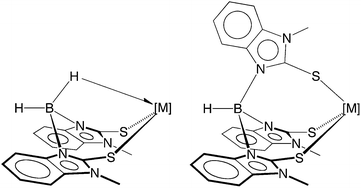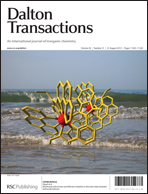The benzannulated bis and tris(mercaptoimidazolyl)borohydride compounds, [BmMeBenz]Na and [TmMeBenz]Na, have been synthesized via the reactions of NaBH4 with two and three equivalents of 1-methyl-1,3-dihydro-2H-benzimidazole-2-thione, respectively. X-ray diffraction studies on the THF adducts, {μ-[BmMeBenz]Na(THF)2}2 and {[TmMeBenz]Na}2(μ-THF)3, indicate that both compounds are dinuclear but differ according to the nature of the bridging ligand. Specifically, {μ-[BmMeBenz]Na(THF)2}2 possesses bridging [BmMeBenz] ligands and terminal THF ligands, while {[TmMeBenz]Na}2(μ-THF)3 possesses terminal [TmMeBenz] ligands and bridging THF ligands. The tris(mercaptoimidazolyl)borohydride ligand of {[TmMeBenz]Na}2(μ-THF)3 coordinates in a κ3-manner, which is in marked contrast to the κ2-, κ1- and κ0-modes that have been reported for various [TmMe]Na derivatives. Density functional theory (DFT) geometry optimization calculations of the anions [TmMeBenz]− and [TmMe]− in the gas phase indicate that the conformation required for κ3-S3 coordination, i.e. one in which the three sulfur donors point away from the B–H group, is relatively more stable for [TmMeBenz]− than for [TmMe]−, and thus provides a rationalization for the observation that benzannulation enables κ3-coordination of tris(mercaptoimidazolyl)borohydride ligand in {[TmMeBenz]Na}2(μ-THF)3. Furthermore, comparison of the molecular structure and IR spectroscopic properties of [TmMeBenz]Re(CO)3 with those of [TmMe]Re(CO)3 indicates that benzannulation reduces the electron donating properties of the ligand, but has little effect on its steric properties. {μ-[BmMeBenz]Na(THF)2}2 and {[TmMeBenz]Na}2(μ-THF)3 react with [Me3PCuCl]4 to give [BmMeBenz]CuPMe3 and [TmMeBenz]CuPMe3, the first pair of structurally related bis and tris(mercaptoimidazolyl)hydroborato copper(I) compounds.


 Please wait while we load your content...
Please wait while we load your content...